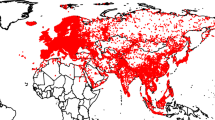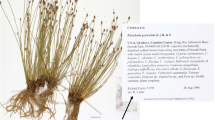Abstract
This paper presents the results of a study conducted at the request of the Government of Guyana by the Centre for the Study of Biological Diversity at the University of Guyana, and the Smithsonian Institution. The purpose of the study was to evaluate the utility of using systematic collections in identifying areas with a high priority for conservation. A biodiversity database and a gazetteer were assembled and interpreted primarily through the use of maps generated in ARC/INFO and ArcView. The data were examined to determine coverage and completeness, and while in general the results support a continued use of the methodology for making informed decisions in conservation related issues, several recommendations are offered in order to enhance the data. The primary use of the results of this study is in the identification of areas of interest for conservation and in the location of eleven areas covering most ecoregions in Guyana that are in need of additional study. The eleven areas have been chosen to avoid areas that are already allocated to logging and mining concessions or Amerindian lands. While it is true that this study would benefit from additional data and further analysis of those data, it is also true that decisions concerning areas for conservation in Guyana are being made in the near future, and if any data are to be used in this process, it will be those data presented in this paper.
Similar content being viewed by others
References
Agriconsulting (1993) Preparatory study for the creation of a protected area in the Kanuku Mts. region of Guyana. Report prepared for the European Union.
Austin MP and Heyligers PC (1989) Vegetation survey design for conservation: gradsect sampling of forests in north-east New South Wales. Biol. Conserv. 50: 13–32
Austin MP and Heylingers PC (1991) New approach to vegetation survey design: gradsect sampling. In: Margules CR and Austin MP (eds) Nature Conservation: Cost-effective Biological Surveys and Data Analysis, pp 31–36. CSIRO, Australia
Beebe W (1925) Jungle Days. Garden City Publishing, New York
Beebe W (1927) Edge of the Jungle. Garden City Publishing, New York
Boggan J, Funk V, Kelloff C, Hoffman M, Cremers G and Feuillet C (1992) Checklist of the Plants of the Guianas. Smithsonian Institution, Washington, DC
Boggan J, Funk V, Kelloff C, Hoffman M, Cremers G and Feuillet C (1997) Checklist of the Plants of the Guianas, 2nd edition. Smithsonian Institution, Washington, DC
Borchsenius F (1997) Patterns of plant species endemism in Ecuador. Biodiversity and Conservation 6: 379–399
Brown KS (1991) Conservation of neotropical environments: insects as indicators. In: Collins NM and Thomas JA (eds) The Conservation of Insects and their Habitats, pp 350–404. Academic Press, London
Busby JR (1991) BIOCLIM - a bioclimate analysis and prediction system. In: Margules CR and Austin MP (eds), Nature Conservation: Cost Effective Biological Surveys and Data Analysis. CSIRO: Australia
Carpenter G, Gillison AN et al. (1993) Domain: a flexible modelling procedure for mapping potential distributions of plants and animals. Biodiversity and Conservation 2: 667–680
Coddington J, Hammond P, Olivieri S, Robertson J, Sololov V, Stork N and Taylor E (1991) Monitoring and inventorying biodiversity from genes to ecosystems. In: Solbrig O (ed) From Genes to Ecosystems: A Research Agenda for Biodiversity, pp 83–117. IUBS, Paris
Colwell T and Coddington J (1994) Estimating terrestrial biodiversity through extrapolation. Philosophical Transaction of the Royal Society of London 345: 101–118
Cotterill FPD (1995) Systematics, biological knowledge and environmental conservation. Biodiversity and Conservation 4: 183–205
Dalfelt A (1978) Nature Conservancy survey of the Republic of Guyana. Report presented to the Nature Conservancy
Diamond JM (1985) Introductions, extinctions, exterminations, and invasions. In: Case TJ and Diamond JM (eds) Community Ecology pp 65–79. Harper and Row, New York
Dinerstein E, Olson DM, Graham DJ, Webster AL, Primm SA, Bookbinder MP and Ledec G (1995) A Conservation Assessment of the Terrestrial Ecoregions of Latin America and the Caribbean. The International Bank for Reconstruction and Development/The World Bank, Washington, DC
Erwin TL (1982) Tropical forests: their richness in Coleoptera and other arthropod species. Coleopterists' Bulletin 36: 74–75
Erwin TL (1983) Tropical forest canopies: the last biotic frontier. Bulletin of the Entomological Society of American 29: 4–9
Filer D (1994) BRAHMS: A Pocket Introduction and Demonstration Guide
Funk V (1997) Using collections data and GIS to examine biodiversity information levels in Guyana. In: Hoagland KE and Rossman AY (eds) Global Genetic Resources: Access, Ownership, and Intellectual Property Rights, pp 117–128. Association of Systematic Collections, Washington, DC
Gadgil M, Berkes F and Folke C (1993) Indigenous knowledge for biodiversity conservation. Ambio 22: 151–156
GAHEF (1991) National Forestry Action Plan, project No 22: Development of a protected area system. Report by the Guyana Agency for Health, Environmental Education and Food Policy
GAHEF (1992) Guyana/UNEP country study of biological diversity. Report presented to the UNEP. Report by the Guyana Agency for Health, Environmental Education and Food Policy
Glowka L, Burhenne-Guilmin F and Synge H (1994) A Guide to the Convention on Biological Diversity. Gland: IUCN
Goodman SM and Lanyon SM (1994) Scientific collecting. Conserv. Biol. 8: 314–315
Gorts-Van Rijn ARA (1990) Flora of the Guianas. Koenigstein: Koeltz Scientific Books
Helliwell DR (1969) Valuation of wildlife resources. Reg. Stud. 3: 41–47
Huber O, Gharbarran G and Funk V (1995) Vegetation Map of Guyana. Centre for the Study of Biological Diversity, Guyana
Jones PG, Beebe SE and Thome J (1997) The use of geographical information systems in biodiversity exploration and conservation. Biodiversity and Conservation 6: 947–958
Kelloff C and Funk VA (1998) Preliminary Checklist of the Plants of Kaieteur National Park, Guyana. Smithsonian Institution, Washington, DC
Kim KC and McPheron BA (eds) (1993) Evolution of Insect Pests pp 3–26. New York: John Wiley and Sons, Inc
Lund HG and Thomas CE (1995) A Primer on Evaluation and Use of Natural Resource Information for Corporate Data Bases, General Technical Support WO-62. USDA, Washington, DC
MacKinnon J (1992) The Logic of Mass. Asian Bureau for Conservation
MacKinnon J (1994) A Method for Evaluating and Classifying Habitat Importance for Biodiversity Conservation.WCMC/WCI Meeting on Identification of Habitat Criteria, 11- 12 October 1994. Cambridge, UK
Margules CR and Usher MB (1981) Criteria used in assessing wildlife conservation potential: a review. Biol. Conserv. 21: 79–109
Margules CR and Redhead TD (1991) Guidelines for using the BioRap Methodology and Tools. CSIRO, Australia
May RM (1986) How many species are there? Nature 324: 514–515
May RM (1988) How many species are there on Earth? Science 241: 1441–1449
May RM (1990a) How many species? Philosophical Transaction of the Royal Society of London 330: 292–304
May RM (1990b) Taxonomy as destiny. Nature 347: 129–130
McNeely J (1995) Human influences on biodiversity. In: Heywood VH and Watson RT (eds) Global Biodiversity Assessment, pp 715–821. Cambridge University Press, UNDP
McNeely J, Miller KR, Reid WV, Mittermeier RA and Werner TB (1990) Conserving the World's Biological Diversity. World Resources Institute, IUCN, World Bank, World Wildlife Fund, Conservation International: Washington, DC and Gland
Miller EH (1993) Biodiversity research in museums: a return to basics. In: Fenger MA, Miller EH, Johnson JF and Williams EJR (eds) Our Living Legacy: Proceedings of a Symposium on Biological Diversity pp 141–173. Royal British Colombia Museum, Victoria
Mittermeier R, Myers N, Thomsen JB, DaFonseca GAB and Olivieri S (1998) Biodiversity hotspots and major tropical wilderness areas: approaches to seting conservation priorities. Conserv. Biol. 12: 516–520
National Research Council (1993) A Biological Survey of the Nation. National Academy Press, Washington, DC
Neldner VJ (1995) Using Geographic Information Systems (GIS) to determine the adequacy of sampling in vegetation surveys. Biol. Conserv. 73: 1–17
Nix HA and Gillison AN (1985) Towards an operational framework for habitat and wildlife management. In: Kikkawa J (ed) Wildlife Management in the Forests and Forestry-controlled Lands in the Tropics and Southern Hemisphere pp 39–55. International Union of Forestry Research Organizations, St. Lucia, Australia
Olivieri ST (1995) Data information and management communication. In: Heywood VH and Watson RT (eds), Global Biodiversity Assessment, pp 607–670. UNEP, Cambridge University Press, United Kingdom
Olson DM and Dinerstein E (1998) The global 200: a representation approach to conserving the earth's most biologically valuable ecoregions. Conserv. Biol. 12: 502–515
Painter M (1988) Co-management with whom? Conservation and development in Latin America. Paper presented in the symposium 'Culture: the missing component in conservation and development', April 8- 9, 1988, Washington, DC
Parker T, Foster RB, Emmons LH, Freed P, Forsyth AB, Hoffman B and Gill BD (1993) RAP: A Biological Assessment of the Kanuku Mountain Region of Southwestern Guyana. Conservation International, Washington, DC
Pimm SL, and Gilpin ME (1989) Theoretical issues in conservation biology. In: May RM and Levin SA (eds) Perspectives in Ecological Theory, pp 287–305. Princeton University Press, Princeton, NJ
Prance GT (1994) Amazonian tree diversity and the potential for supply of non-timber forest products. In: Leakey RRB and Newton AC (eds) Tropical Trees: The Potential for Domestication and the Rebuilding of Forest Resources, pp 7–15. HMSO, London
Prendergast JR, Quin RM, Lotten JH, Eversham BH and Gibbons DW(1993) Rare species, the coincidence of diversity hotspots and conservation strategies. Nature 365: 335–337
Pressey RL, Humphries CJ, Margules CR, Vane-Wright RI and Williams PH (1993) Beyond opportunism: key principles for systematic reserve selection. Trends in Ecology and Evolution 8: 124–128
Putney Allen D (1990) Guyana, identification of potential biosphere reserves and world heritage sites. Report prepared for the Government of Guyana
Ramdass I and Hanif M (1990) A definition of priority conservation areas in Amazonia: Guyana country paper. In: Conservation International (ed) Workshop' 90: Biological Priorities for Conservation in Amazonia: Conservation International, Washington, DC
Redford KH (1992) The empty forest. BioScience 42: 412–422
Samways MJ (1993) A spatial and process sub-regional framework for insect and biodiversity conservation research and management. In: Gaston KJ, New TR and Samways MJ (eds) Perspectives on Insect Conservation, pp 1–27. Intercept, Andover, UK
Schuerholz G (1992) Kaieteur National Park Guyana: management plan, Vol. II. Report prepared forWorld Wildlife Fund, USA
Sizer N (1996) Profit without Plunder: Reaping Revenue from Guyana's Tropical Forests without Destroying Them. World Resources Institute, Washington, DC
Smith AP, Horning N and Moore D (1997) Regional biodiversity planning and lemur conservation with GIS in western Madagascar. Conserv. Biol. 11: 498–512
Snyder D (1966) The Birds of Guyana. Peabody Museum, Salem
Spellerberg IF (1994) Evaluation and Assessment for Conservation. Chapman and Hall, London
Spellerberg IF (1992) Biological Conservation. Cambridge University Press, Cambridge
Stevens L and Traylor MA (1985) Ornithological Gazetteer of the Guianas. Harvard University Press, Cambridge, Massachusetts
Stork NE (1995) In: Global Biodiversity Assessment Heywood VH and Watson RT (eds) Inventorying and Monitoring, pp 457–543. Cambridge University Press, UK
Stork NE (1988) Insect diversity: facts, fiction and speculation. Biological Journal of the Linnnean Society 35: 321–337
Usher MB (1986) Wildlife conservation evaluation: attributes, criteria and values. In: Usher MB (ed) Wildlife Conservation Evaluation, pp 3–44. Chapman and Hall, London
Willis CK, Cowling RM and Lombard AT (1996) Patterns of endemism in the limestone flora of South African lowland fynbos. Biodiversity and Conservation 5: 55–73
Wilson EO (1987) The little things that run the world: the importance and conservation of invertebrates. Conserv. Biol. 1: 344–346
WRI/IUCN/UNEP (1992) Global Biodiversity Strategy: guidelines for action to save, study, and use earth's biotic wealth sustainably and equitably. World Resources Institute, Washington, DC; World Conservation Union, Gland, Switzerland; The United Nations Environment Programme, Nairobi
Author information
Authors and Affiliations
Rights and permissions
About this article
Cite this article
Funk, V., Zermoglio, M.F. & Nasir, N. Testing the use of specimen collection data and GIS in biodiversity exploration and conservation decision making in Guyana. Biodiversity and Conservation 8, 727–751 (1999). https://doi.org/10.1023/A:1008877222842
Issue Date:
DOI: https://doi.org/10.1023/A:1008877222842




